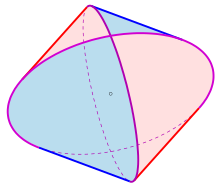
Back Steinmetz-Körper German Sólido de Steinmetz Spanish Solido di Steinmetz Italian 스타인메츠 다면체 Korean Steinmetzlichaam Dutch Тело Штейнмеца Russian 牟合方盖 Chinese

In geometry, a Steinmetz solid is the solid body obtained as the intersection of two or three cylinders of equal radius at right angles. Each of the curves of the intersection of two cylinders is an ellipse.
The intersection of two cylinders is called a bicylinder. Topologically, it is equivalent to a square hosohedron. The intersection of three cylinders is called a tricylinder. A bisected bicylinder is called a vault,[1] and a cloister vault in architecture has this shape.
Steinmetz solids are named after mathematician Charles Proteus Steinmetz,[2] who solved the problem of determining the volume of the intersection. However, the same problem had been solved earlier, by Archimedes in the ancient Greek world,[3][4] Zu Chongzhi in ancient China,[5] and Piero della Francesca in the early Italian Renaissance.[3] They appear prominently in the sculptures of Frank Smullin.

- ^ Cite error: The named reference
mathworldwas invoked but never defined (see the help page). - ^ Howard Eves, Slicing it thin, in: David Klarner, The mathematical Gardner, Wadsworth International 1981, S. 111
- ^ a b Peterson, Mark A. (1997). "The geometry of Piero della Francesca". The Mathematical Intelligencer. 19 (3): 33–40. doi:10.1007/BF03025346. MR 1475147. S2CID 120720532.
- ^ Jan Hogendijk (2002). "The surface area of the bicylinder and Archimedes' Method". Historia Mathematica. 29 (2): 199–203. doi:10.1006/hmat.2002.2349. MR 1896975.
- ^ Swetz, Frank J. (February 1995). "The volume of a sphere: A Chinese derivation". The Mathematics Teacher. 88 (2): 142–145. doi:10.5951/MT.88.2.0142. JSTOR 27969235.
© MMXXIII Rich X Search. We shall prevail. All rights reserved. Rich X Search